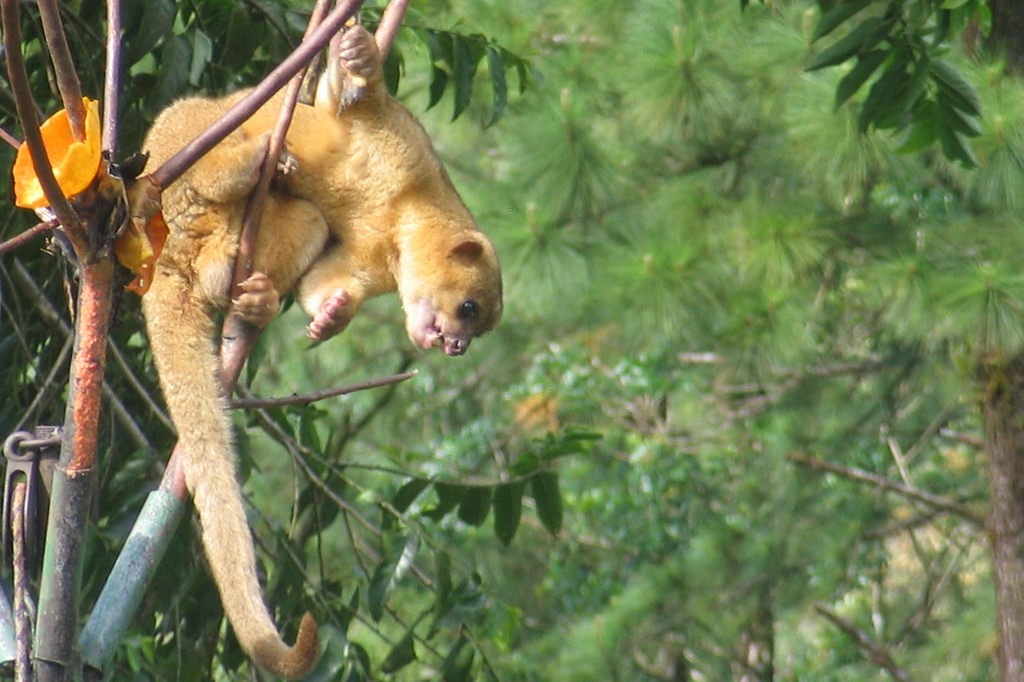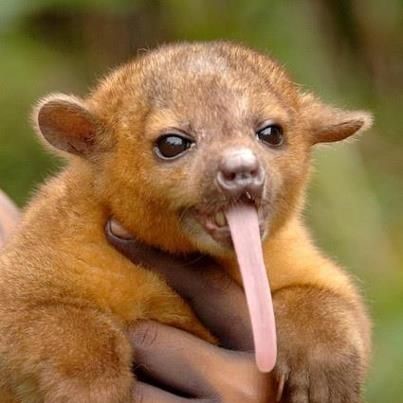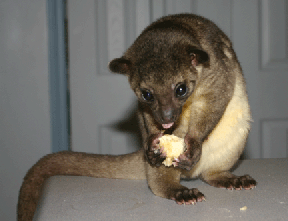Caring For a Pet Kinkajou
Many people are not only unfamiliar with kinkajous as pets, but they’ve never even heard of this interesting animal’s existence. Some may have been introduced to this species through the news of Paris Hilton adopting one, only for it to be confiscated because they are illegal in California (as many animals unfortunately are). They resemble monkeys, but they are actually related to raccoons. Before you consider bringing one of these fascinating animals into your home, consider that they are a relatively high-maintenance pet that will require special care.
- The species name of the kinkajou is Potos flavus although there are a few subspecies, and in captivity they are sold as either ‘large’ or ‘small’ types. The most common types are the ‘smaller’ variety.
- Kinkajous are also called honey bears due to their diet of tree nectar and honey.
- These species have a very long lifespan of up to 40 years, but the average range is around 20-25 years.
- Kinkajous vary in size but generally weigh around 7 pounds and their body length measures about 16-25 inches without their tail. They are about the size of a small housecat.
In the wild

ryanacandee (CC BY 2.0) Via Flickr
Kinkajous originate from the rainforests of Central and South America. In the wild, they are arboreal and nocturnal, spending most of their time in the tree tops. They use their prehensile tails like an appendage to grip tree branches similarly to monkeys, and they can also turn their feet backwards to assist in climbing. While they are related to raccoons, coatimundis, and ring-tailed cats, their diet consists of mostly fruit and honey, the latter which they gather by using their long tongue.
They do however consume animal material such as frogs, eggs, and insects, and they have sharp carnivore-like teeth. Kinkajous produce offspring once a year through spring and summer. On the IUCN Red List they are listed as least concern and there is no evidence that their populations are declining, therefore they are not threatened by the exotic pet trade.
Living with a kinkajou and behavior
Like their close relatives the raccoons, kinkajous can be mischievous and destructive in the typical household, which means their cage should provide most of their needs. While they can be friendly and curious about humans when they’ve been socialized from a young age, they are still prone to bouts of aggression which could arise from hormonal shifts. This might make them seem unpredictable. They are also prone to food aggression and guarding behaviors.
While kinkajous do not have a ‘foul’ smelling odor, they can be quite messy, using the bathroom wherever they are standing much like a parrot. Their eating habits can cause sticky fruits to end up throughout the enclosure (which can attract fruit flies) and the habitat will require frequent cleaning. Kinkajous produce many unique vocalizations that vary from high-pitched sounds like chirping, shrieking and whistling to huffing and ‘barking’. As they are nocturnal, this can become annoying if they are placed in your bedroom. The proper cage will determine the level of success you will have with a pet kinkajou.

Silk Knoll CC by 2.0 Via Flickr
Personality
Most of the time, a well-socialized kinkajou will be a well-mannered and somewhat affectionate pet. They are often comfortable around people, even those who aren’t their owners, and will climb on their shoulders. There have been enough reports of unprovoked aggression in kinkajous for new owners to take notice. Unruly and occasionally aggressive behavior is said to peak at around 2 years old and last until around 5 years, but spaying and neutering might have a positive effect on this issue. Very few animals, especially those that aren’t domesticated, can be expected to be well-behaved 100% of the time.
The Kinkajou Cage
As kinkajous are tree dwellers, their cage should be tall in addition to being long. This is a somewhat large, active, and mentally complex animal and the cage really shouldn’t be skimped on with the hopes that its needs can be met with hour-long play sessions. The cage should be big enough for the animal to maneuver around comfortably for a few feet.
Many owners will suggest a 6x4x6 foot enclosure or larger, which is your best bet for a satisfied kinkajou and less stress for you as its owner. Smaller is possible, but this may depend on the animal and if it does not seem sufficient, you will need to upgrade.
Remember that the kinkajou is mostly active at night, so it will need to have plenty of room to play while you sleep. The cage should contain the basic necessities, such as climbing branches and ropes, ledges, shelves, and suspended bowls for feeding and toys.
Try to make the environment complex to increase its enrichment value. Your kinkajou can sleep or rest in a hammock, and a homemade nesting box is good for the main sleeping quarters. One easy option is a plastic bin with a hole cut out, mounted to the wall. Building your own cage is always a great option, but for store-bought cages, large walk-in aviaries or tall dog kennels work great in climate-controlled rooms. You might want to consider adding an outdoor enclosure so your kinkajou can get some sun and fresh air.

Oli23000 CC BY 2.0 Via Flickr
Kinkajou diet and feeding
Kinkajous are omnivores that consume mostly fruits and tree nectar, which is why they are also referred to as ‘honey bears’. In captivity, they can be fed many different types of fruits, including grapes, bananas, papaya, mango, figs, and pomegranate. Tropical fruits tend to more closely match those which they’d get in the wild, but avoid citrus (oranges, grapefruit, ect). Various vegetables and flowers (hibiscus, candela, and other edibles) can also be offered. For protein, the monkey biscuits by Mazuri or Zupreem are a good choice and enjoyed by many animals. Hard- boiled eggs, boiled chicken, and some dog foods can supplement the diet.
Kinkajous can be messy eaters, so use a bowl that can securely attach to the side of the cage. Place the water bowl away from the food bowls to help prevent them from getting dirtied, however if this still happens, one good option is to use a glass hamster style dripper water bottle for either rabbits or dogs, just be sure that the kinkajou knows how to use it before removing the bowls.
Kinkajous can live for over 20 years, so if you are seriously considering getting one, ponder the decision thoroughly. Be aware that these animals, like many exotics, do not re-home well and this can be detrimental to the animal’s welfare. If you need to go away, who will watch your pet? Be sure to continue to research before and after the animal is acquired, as unlike dogs and cats, kinkajou care has not been thoroughly studied.







